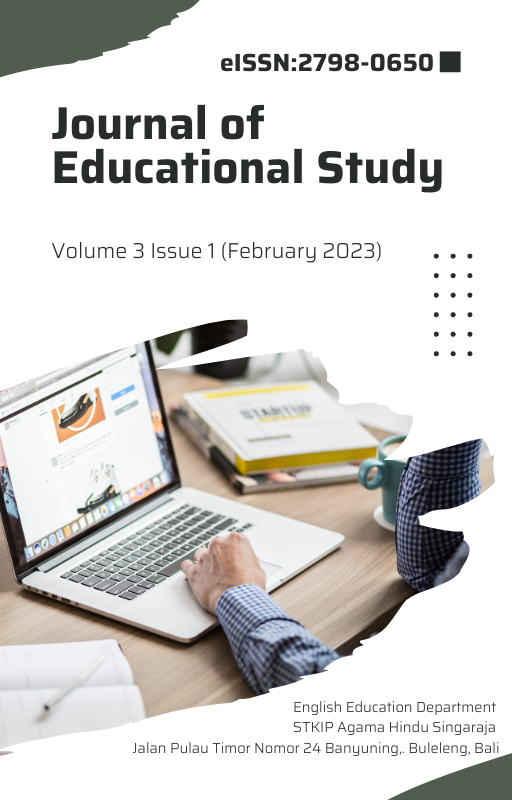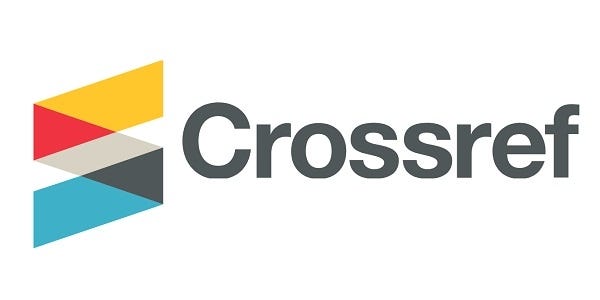Students’ Learning Approach in SMK Negeri 1 Singaraja in The EFL Online Learning Context
DOI:
https://doi.org/10.36663/joes.v3i1.380Keywords:
EFL, Online Learning, Students' Learning ApproachAbstract
This study investigated the learning approach of tenth-grade students in SMK Negeri 1 Singaraja in the EFL online learning context. The study employed quantitative research. The sample involves 89 students in tenth grade in the Hotel Accommodation program. This study used the R-SPQ-2F questionnaire which was modified for the online learning context. The data analysis was implemented in the R-SPQ-2F questionnaire mean score analysis. The results showed that tenth-grade students in SMK Negeri 1 Singaraja tend to surface approach (tsap= 29.55 > tdap= 28.32). It is suggested students will study in-depth to build meaningful learning by understanding concepts and developing potential optimally in the implication of learning English as a foreign language in the online learning context.
Downloads
References
Albiansyah, A., Prasetyo, A., & Minkhatunnakhriyah, M. (2020). The communicativeness of English tests at vocational high school. TRANS-KATA: Journal of Language, Literature, Culture and Education, 1(1), 29–35. https://doi.org/10.54923/transkata.v1i1.7
Alkhateeb, M. A., & Milhem, O. A. Q. B. (2020). Student’s concepts of and approaches to learning and the relationships between them. Cakrawala Pendidikan, 39(3), 620–632. https://doi.org/10.21831/cp.v39i3.33277
Asikainen, H., & Gijbels, D. (2017). Do Students Develop Towards More Deep Approaches to Learning During Studies? A Systematic Review on the Development of Students’ Deep and Surface Approaches to Learning in Higher Education. Educational Psychology Review, 29(2), 205–234. https://doi.org/10.1007/s10648-017-9406-6
Biggs. (1987). Study Process Questionnaire Manual. Student Approaches to Learning and Studying. In Australian Education Research and Development.
Biggs, J. (1988). Assessing student approaches to learning. Australian Psychologist, 23(2), 197–206. https://doi.org/10.1080/00050068808255604
Biggs, J. (1989). Approaches to the enhancement of tertiary teaching. Higher Education Research & Development, 8(1), 7–25. https://doi.org/10.1080/0729436890080102
Biggs, J., Kember, D., & Leung, D. Y. P. (2001). The revised two-factor Study Process Questionnaire: R-SPQ-2F. The British Journal of Educational Psychology, 71, 133–149. https://doi.org/10.1348/000709901158433
Budiarta, I. K., & Santosa, M. H. (2020). TPS-Flipgrid: Transforming EFL speaking class in the 21st century. English Review: Journal of English Education, 9(1), 13–20. https://doi.org/https://doi.org/10.25134/erjee.v9i1.3801
Cheng, X. (2000). Asian students’ reticence revisited. System, 28(3), 435–446. https://doi.org/10.1016/S0346-251X(00)00015-4
Dardjowidjojo, S. (2006). the Implementability of Western. Indonesian Journal of English Language Teaching, 2(1), 1–20.
Desierto, A., De Maio, C., O’Rourke, J., & Sharp, S. (2018). ’Deep or surface? The learning approaches of enabling students in an Australian public university. Edith Cowan University, 1976, 1–10.
Dinsmore, D. L. (2017). Toward a dynamic, multidimensional research framework for strategic processing. Educational Psychology Review, 29, 235–268. https://doi.org/https://doi.org/10.1007/s10648-017- 9407-5
Dipayana, I. K. M., Gading, I. K., & Japa, I. G. N. (2019). Pengaruh Pendekatan Pembelajaran Matematika Realistik Indonesia terhadap Hasil Belajar Matematika Ditinjau dari Minat Komputasi. Mimbar PGSD Undiksha, 7(3), 279–288.
Gan, Z. (2009). “Asian learners” re-examined: An empirical study of language learning attitudes, strategies and motivation among mainland Chinese and Hong Kong students. Journal of Multilingual and Multicultural Development, 30(1), 41–58. https://doi.org/10.1080/01434630802307890
Handoko, P., Parawiradiredja, S., & Santoso, B. (2020). Pengajaran Kompetensi Bahasa Inggris Untuk Sekolah Menengah Kejuruan. Jurnal Layanan Masyarakat (Journal of Public Services), 3(1), 11. https://doi.org/10.20473/jlm.v3i1.2019.11-17
Hu, X., & Yeo, G. B. (2020). Emotional exhaustion and reduced self-efficacy: The mediating role of deep and surface learning strategies. Motivation and Emotion, 44(5), 785–795. https://doi.org/10.1007/s11031-020-09846-2
Hulreski, M., Syatriana, E., & Ardiana. (2020). View of An Investigation of Deep and Surface Learning Approach towards English Vocabulary Acquisition of EFL Students.pdf. Middle Eastern Journal of Research in Education and Social Sciences (MEJRESS), 1(1), 15–26. https://doi.org/https://doi.org/10.47631/mejress.v1i1.5
Hussin, F., Hamed, S., & Jam, S. M. (2017). Approaches to learning of engineering students: Deep or surface. Int Acad Res J Soc Sci, 3(1), 122–127.
Irgatoğlu, A. (2021). L2 Motivational Self System and Learning Approaches of High School Students. Education Quarterly Reviews, 4(2), 240–252. https://doi.org/10.31014/aior.1993.04.02.243
Iswati, L. (2019). Pelatihan TOEIC untuk siswi-siswi Tata Busana SMK Muhammadiyah Bangunjiwo, Kasihan, Bantul, Yogyakarta. Indonesian Journal of Community Services, 1(2), 134. https://doi.org/10.30659/ijocs.1.2.134-143
Kurniawati, K. L. (2022). Students’ Need Analysis in the Content of English for Hotel Accommodation of Vocational High School. JIIP - Jurnal Ilmiah Ilmu Pendidikan, 5(3), 907–914. https://doi.org/10.54371/jiip.v5i3.512
Lee, J., Kim, R. J. Y., & Choi, H. (2020). Most surface learning in the third year: Dental student learning approaches and implications for curriculum and assessment. Journal of Dental Education, 84(4), 464–472. https://doi.org/10.1002/jdd.12043
Lumatauw, L., Wollah, M., & Tulangow, R. (2020). Application of Student Centered Learning (SCL) Method through Discovery Strategies in Vocational Educations. Open Journal of Social Sciences, 08(11), 82–90. https://doi.org/10.4236/jss.2020.811008
Mahbub, A. M. (2019). English teaching in vocational high school: A need analysis. JEELS (Journal of English Education and Linguistics Studies), 5(2), 229–258.
Marton, F., & Saljo, R. (1976). on Qualitative Differences in Learning: I-Outcome and Process*. British Journal of Educational Psychology, 46(1), 4–11. https://doi.org/10.1111/j.2044-8279.1976.tb02980.x
Marušić, I., Jugović, I., & Lončarić, D. (2017). Approaches to learning of first-year and fifth-year student teachers: are there any differences? European Journal of Teacher Education, 40(1), 62–75. https://doi.org/10.1080/02619768.2016.1251898
Miller, L. C.; Northern, T. (2011). 21st Century skills: prepare student for the future. Kappa Delta Pi Record, 121–123.
Mulyani, E. R., Suherdi, D., & Sundayana, W. (2020). Indonesia Islamic senior high school students’ English learning conceptions and strategies. Indonesian Journal of Applied Linguistics, 9(3), 572–579. https://doi.org/10.17509/ijal.v9i3.23207
O’Keefe, Paul A.; Horberg, E. J.; Plante, I. (2017). The Multifaceted Role of Interest in Motivation and Engagement. In The Science of Interest (pp. 49–67). Springer. https://doi.org/DOI 10.1007/978-3-319-55509-6_3
Precourt, E., & Gainor, M. (2019). Factors affecting classroom participation and how participation leads to a better learning. Accounting Education, 28(1), 100–118. https://doi.org/10.1080/09639284.2018.1505530
Rakhmanina, L., Feny, M., Br Halolo, F., Syafryadin, & Noermanzah. (2020). View of Students’ Perception on Online English Learning during Covid-19 Pandemic Era.pdf (pp. 428–439). https://doi.org/https://doi.org/10.31540/silamparibisav3i2
Rakhmat, J. (2009). Metode penelitian komunikasi. PT Remaja Rosdakarya.
Rosito, A. (2020). Learning Strategy Approaches: Are There Differences Among Various Field Of Studies? https://doi.org/10.4108/eai.20-9-2019.2296623
Santyasa, I. wayan. (2018). Student centered learning : Alternatif pembelajaran inovatif abad 21 untuk menyiapkan guru profesional. Prosiding Seminar Nasional Quantum, 25, xix–xxxii.
Smarandache, I. G., Maricutoiu, L. P., Ilie, M. D., Iancu, D. E., & Mladenovici, V. (2020). Students’ approach to learning: evidence regarding the importance of the interest-to-effort ratio. Higher Education Research and Development, 0(0), 1–16. https://doi.org/10.1080/07294360.2020.1865283
Suartini, T. (2019). Influence Application of Learning Model on Vocational Education Based on Quality Issurance. SAGE Open, 9(2). https://doi.org/10.1177/2158244019851552
Sumadi, G. D., Saputra, I. N. P. H., & Agustini, D. A. E. (2022). Tasks Development for English Online Learning at SMA Negeri 4 Singaraja. The Art of Teaching English as a Foreign Language, 3(1), 85–97. https://doi.org/10.36663/tatefl.v3i1.266
Suputra, D. (2021). Teaching English Through Online Learning (A Literature Review). The Art of Teaching English as a Foreign Language, 2(1), 63–67. https://doi.org/10.36663/tatefl.v2i1.104
Takase, M., Niitani, M., & Imai, T. (2020). What educators could do to facilitate students’ use of a deep approach to learning: A multisite cross-sectional design. Nurse Education Today, 89(August 2019), 104422. https://doi.org/10.1016/j.nedt.2020.104422
Tambunsaribu, G.; Galingging, Y. (2022). Masalah yang dihadapi pelajar bahasa inggris dalam memahami pelajaran bahasa inggris. Dialetika: Jurnal Bahasa, Sastra Dan Budaya, 8(1), 30–41. https://doi.org/10.33541/dia.v8i1.3110
Tongco, M. D. C. (2007). Purposive sampling as a tool for informant selection. Ethnobotany Research and Applications, 5, 147–158. https://doi.org/https://doi.org/10.17348/era.5.0.147-158
Triyanto. (2019). The Academic Motivation of Papuan Students in Sebelas Maret University, Indonesia. SAGE Open, 9(1). https://doi.org/10.1177/2158244018823449
Vogt, K., Kantelinen, R. (2013). Vocationally Oriented Language Learning Revisited. ELT Journal, 67(1), 62–69. https://doi.org/https://doi.org/10.1093/elt/ccs049
Wijaya, E. Y., Sudjimat, D. A., & Nyoto, A. (2016). Transformasi pendidikan abad 21 sebagai tuntutan pengembangan sumber daya manusia di era global [The transformation of 21st century education as a demand for human resource development in the global era]. Prosiding Seminar Nasional Pendidikan Matematika 2016, 1, 263–278.
Wijaya, I. N. A., Ratminingsih, N. M., & Dewi, N. L. P. E. S. (2022). English Language Education Student-Teachers’ Perception on TPACK. The Art of Teaching English as a Foreign Language, 3(1), 9–18. https://doi.org/10.36663/tatefl.v3i1.193
Wiraningsih, P., & Santosa, M. H. (2020). EFL teachers ’ challenges in promoting learner autonomy in the 21 st -. Journal on English as a Foreign Language, 10(2), 290–314.
Downloads
Published
How to Cite
Issue
Section
License
Copyright (c) 2022 Putu Vergi Damayanti, Made Hery Santosa, I Putu Ngurah Wage Myartawan

This work is licensed under a Creative Commons Attribution 4.0 International License.
https://creativecommons.org/licenses/by-sa/4.0/















